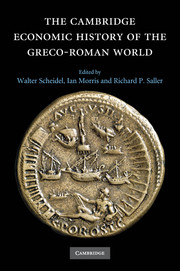Book contents
- Frontmatter
- 1 Introduction
- Part I Determinants of Economic Performance
- Part II Early Mediterranean Economies and the Near East
- 7 The Aegean Bronze Age
- 8 Early Iron Age Greece
- 9 The Iron Age in the Western Mediterranean
- 10 Archaic Greece
- 11 The Persian Near East
- Part III Classical Greece
- Part IV The Hellenistic States
- Part V Early Italy and the Roman Republic
- Part VI The Early Roman Empire
- Part VII Regional Development in the Roman Empire
- Part VIII Epilogue
- Bibliography
- Index
- Map 1.1 The Mediterranean basin"
- Map 10.1 Greek and Phoenician trade in the period of the Persian Wars"
- Map 11.1 The Achaemenid empire"
- Map 12.1 Greece and Asia Minor"
- Map 15.1 The Seleucid empire"
- Map 16.1 Greco-Roman Egypt"
- Map 20.1 The Roman empire at the accession of Vespasian"
- References
8 - Early Iron Age Greece
from Part II - Early Mediterranean Economies and the Near East
Published online by Cambridge University Press: 28 March 2008
- Frontmatter
- 1 Introduction
- Part I Determinants of Economic Performance
- Part II Early Mediterranean Economies and the Near East
- 7 The Aegean Bronze Age
- 8 Early Iron Age Greece
- 9 The Iron Age in the Western Mediterranean
- 10 Archaic Greece
- 11 The Persian Near East
- Part III Classical Greece
- Part IV The Hellenistic States
- Part V Early Italy and the Roman Republic
- Part VI The Early Roman Empire
- Part VII Regional Development in the Roman Empire
- Part VIII Epilogue
- Bibliography
- Index
- Map 1.1 The Mediterranean basin"
- Map 10.1 Greek and Phoenician trade in the period of the Persian Wars"
- Map 11.1 The Achaemenid empire"
- Map 12.1 Greece and Asia Minor"
- Map 15.1 The Seleucid empire"
- Map 16.1 Greco-Roman Egypt"
- Map 20.1 The Roman empire at the accession of Vespasian"
- References
Summary
introduction
In this chapter I review the economic history of Early Iron Age Greece. Following Douglass North, I assume that “the task of economic history [is] to explain the structure and performance of economies through time,” by performance meaning “total output, output per capita, and the distribution of income of the society,” and by structure “those characteristics of a society which we believe to be the basic determinants of performance…political and economic institutions, technology, demography, and ideology.” There is currently little agreement over Early Iron Age economic structures, and no quantitative estimates of performance.
Archaeologists used to call the period 1200–700 bc the Dark Age; most now prefer the less judgmental Early Iron Age (EIA). The dominant narrative tells of the transition from palace to polis. Iron became common between 1100 and 900 bc, but by convention EIA archaeology begins around 1200, with the destruction of the Late Bronze Age (LBA) palaces. The period has existed as a scholarly construct since Schliemann’s excavations in the 1870s. Petrie’s 1890 synchronism between Mycenaean pottery and Egypt’s Nineteenth Dynasty fixed the fall of the palaces around 1200, defining a 500-year interval between Mycenae and the archaic age. Some historians end the EIA in 776, with the first Olympic Games, but most see a longer eighth-century transition, marked by population growth, state formation, colonization, and the return of literacy, representational art, and monumental architecture.
Keywords
- Type
- Chapter
- Information
- The Cambridge Economic History of the Greco-Roman World , pp. 211 - 241Publisher: Cambridge University PressPrint publication year: 2007
References
- 21
- Cited by

